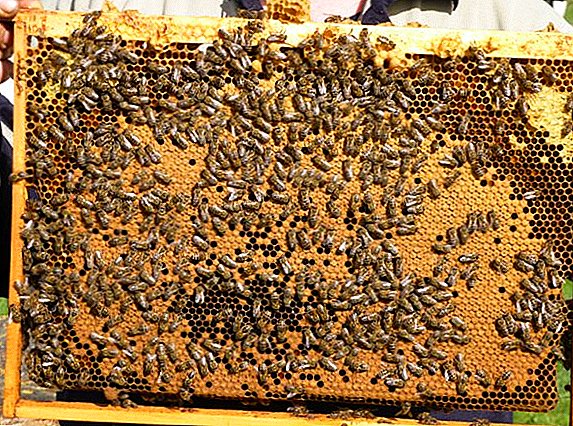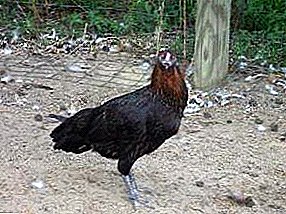 Peony is a fragrant flower that pleases our eyes from May to the end of June. His homeland are subtropics of North America and Eurasia. The genus Peony consists of 34 species, which are divided into 5,000 varieties. At the same time, 4,500 are grassy varieties of peonies and only 500 varieties are tree-like.
Peony is a fragrant flower that pleases our eyes from May to the end of June. His homeland are subtropics of North America and Eurasia. The genus Peony consists of 34 species, which are divided into 5,000 varieties. At the same time, 4,500 are grassy varieties of peonies and only 500 varieties are tree-like.
Did you know? Peony is a long-lived flower, it can grow in one place for ten years. Its stem reaches a height of 1-2 m, and the bud itself can be up to 25 cm in diameter. The flower is unpretentious to care, has a large root and lush foliage. Leaves can be from green to deep purple.
Sorts of peonies
So, what kinds of pions are there? A variety of peonies rolls over. By origin and shape, pions are classified as follows:
Tree, are divided into:
- Sino-European;
- Japanese;
- Hybrids.
Herbaceous, divided into:
- Belotsvetkovy peony (milky-flowered);
- Marin root (deviating peony);
- Medicinal peony;
- Narrow-leaved peony;
- Peony Mlokosevich.
Tree Peony Varieties
Let's analyze in detail the types of tree peonies.
Sino-European
 The stem is tall, terry bud, dense large leaves. Shades can be from pale pink to purple.
The stem is tall, terry bud, dense large leaves. Shades can be from pale pink to purple.
Japanese
The peculiarity of this plant is that it is unpretentious to temperature.
The stamens of the Japanese peony are petal-shaped, sometimes bent inward. The color of the stamens is yellow, pink, red. Petals are arranged in one or several rows.
Hybrids

Peony hybrid is the result of hybridization of grass and tree peony. A distinctive feature of this plant is a bright color of flowers, powerful growth, abundant flowering, frost resistance.
Herb Peonies
Herb varieties of peonies - undemanding plants. In order for this flower to please your eye as long as possible, you should plant it in the section of a different flowering period of each species. This group includes 5 main species.
Belotsvetkovy peony (milky-flowered)
 The plant has many pistils and stamens in the center. The leaves of the flower are with a sharp, slightly corrugated shape. Petals grow in 1-2 rows. The flower of this variety of peonies is large, up to 18 centimeters in diameter. The stem of a flower reaches 90 cm. Due to the variety of colors this plant has no equal. The flowering period - the end of June - the beginning of July.
The plant has many pistils and stamens in the center. The leaves of the flower are with a sharp, slightly corrugated shape. Petals grow in 1-2 rows. The flower of this variety of peonies is large, up to 18 centimeters in diameter. The stem of a flower reaches 90 cm. Due to the variety of colors this plant has no equal. The flowering period - the end of June - the beginning of July.
Marin Root (Evading Peony)
The flowering period of this type of peony - the end of May - the beginning of June. The trunk is thick, the length of the stem can reach from 40 cm to 1 meter. The bud is about 13 cm in diameter. It has a bright pink color. Many gardeners grow this peony variety as a medicinal plant.
Medicinal peony
 The name of the plant speaks for itself, it is used for medicinal purposes. However, over time, gardeners began to plant it because of its aesthetic properties.
The name of the plant speaks for itself, it is used for medicinal purposes. However, over time, gardeners began to plant it because of its aesthetic properties.
The plant has a dark red large single bud up to 12 cm in diameter. The height of the stem varies from 40 to 90 cm. The flower is odorless. The flowering period is the first half of June.
Narrow-leaved peony
 The narrow-leaved peony has a bright crimson or red color. The diameter of the bud is small, only up to 8 cm. The plant will decorate well any open slope at the end of May, but then will lose its charm.
The narrow-leaved peony has a bright crimson or red color. The diameter of the bud is small, only up to 8 cm. The plant will decorate well any open slope at the end of May, but then will lose its charm.
Peony Mlokosevich
Peony Mlokosevich got its name in honor of its discoverer. The plant has a bright yellow color, slightly pinkish stem.
Diameter of a bud is up to 12 cm. This flower blooms slowly, flowering period - May.
Classification of pions in the form of a bud
As you can see, there are many types of peonies in nature, but this is not all. Peonies are also classified by the shape of a bud. Here are the types of peonies are in the form of bud:
- Terry;
- Semi-double;
- Non-shag;
- Anemic;
- Japanese
Terry Peonies
 The group of terry pions is divided into subgroups:
The group of terry pions is divided into subgroups:
- Rose-shaped
- Semi-lobose;
- Crown;
- Hemispheric;
- Spherical.
The terry plants of the group are considered to be the most favorite peonies among gardeners.
These are large flowers with wide petals in three rows. The upper and lower rows have the same color, and the middle one is different in color and consists of narrow petals. Pistils and stamens are developed normally, there are many of them, sometimes they are hidden under the petals.
These varieties of pions include: "A la Maud" (early variety), "Nancy" (early variety), "Aritina Nozen Gloria" (superearly variety), "Raspberry Sande", "Pink Cameo", "Alexander Dumas" (medium early variety), Red Charm, Henry Bokstos (early variety), Solange (late view), Goody, Beev (early variety).
Semi-terry peonies
Peonies of this species have an airy appearance, as they have light and lush flowers. Petals are located in five to seven rows. Their stamens can grow both in the center of the bud and among the petals.
This species includes such varieties of pions as "Miss America" (medium early variety), "Citeria" (medium early variety), "Lastres" (early variety), "En Berry Cases" (early variety).
Pebbles
Peony, simple, non-double, - touchingly gentle. Petals are not very large, arranged in one or two rows. Only one bud to ten petals.
Anemonovid peonies

Volumetric flower in diameter, its center is fully occupied with stamens. Petals are located in one or two rows. Bottom petals are large, rounded, and in the center, on the contrary, narrow and short.
Anemone-like peonies include: "Snow Mountain" (early variety), "Ruth Clay" (medium early variety), "Rhapsody" (medium early variety).
Japanese Peonies
Japanese peonies have stamens, similar to petals, so the middle is more fluffy. The stamens can be the same color as the petals. The flower has a fairly strong trunk. Petals are located in one or two rows.
The Japanese variety of pions include: "Pearl placer" (medium late variety), "Velma Atkinson" (early variety), "Karara", "Hotcolet".
How are peonies divided depending on the timing of flowering
In order for such a colorful and fragrant plant to delight your eye as long as possible, it should be planted in the garden for the duration of flowering. Often, peonies bloom one by one. There are a total of 7 flowering groups:
- Very early - May until June 5;
- Early - from June 5 to 10;
- Middle-early - from 10 to 15 June;
- Medium - from June 15 to June 20;
- Middle-late - from 20 to 25 June;
- Late - from 25 to 30 June;
- Very late - after June 30th.
Pion - unusual flower that will decorate your garden even after it blooms. His lush foliage will give a lot of greenery around. And given his unpretentious care, each gardener will find for himself his own ideal variety.












